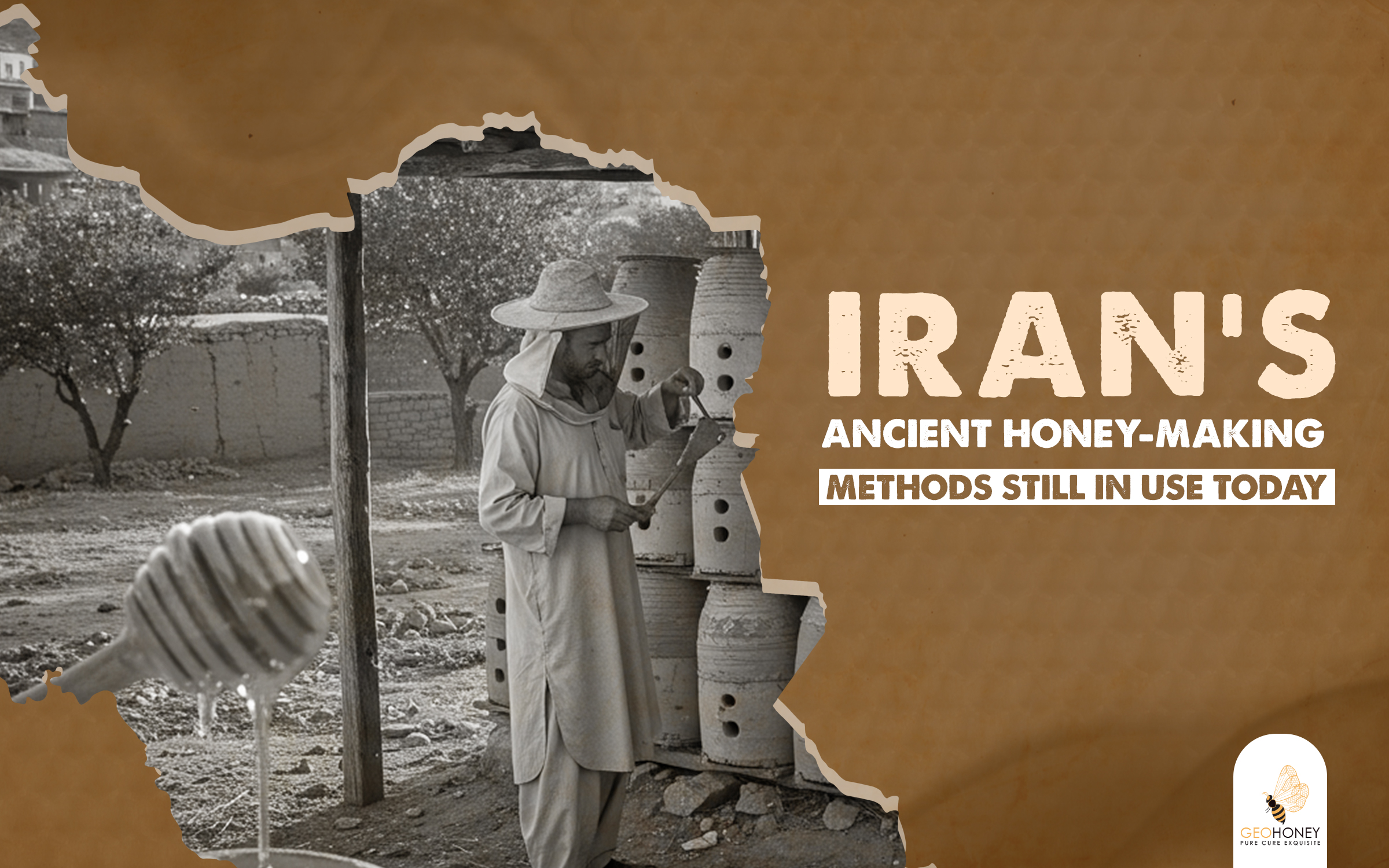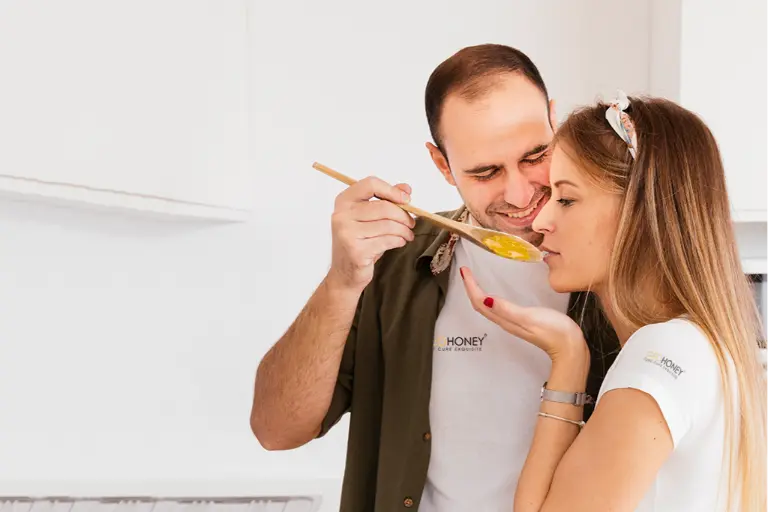- Tokyo: 18:45
- Singapore: 17:45
- Dubai: 13:45
- London: 09:45
- New York: 04:45
Iran’s Ancient Honey-Making Methods Still in Use Today

Iranian civilization is among the oldest and most resilient ones to ever exist on this planet. Known previously as Persia, this part of the world is recognized globally for its rich culture, history, and significant contributions in diverse fields.
From stunning architecture to intricate artistic handcrafted carpets and from unique cuisine to rugged mountainous landscape, this Middle Eastern gem has so much to offer.
There is another very special thing that sets this country apart, and that is its ancient honey-making methods that are still in use even today. Iranian beekeeping methods have endured the test of time. The use of ancient techniques that focus on sustainability and honey purity is exactly what sets Irani honey apart.
This blog will take you through an incredible journey into Iran’s ancient beekeeping practices and honey-making methods. So, without any further ado, let’s get right into it.
Historical Significance of Honey in Iranian Culture
Nomadic Beekeeping in Iran: Migration of Beehives
Traditional Iranian Hives
A Focus on Purity and Rawness
Ancient Iranian Honey-Making: A Sustainable Approach
Factors that Threaten This Age-Old Tradition
Preservation Efforts are Underway
Historical Significance of Honey in Iranian Culture
Iranians have been nurturing hives and bees for more than 2000s years, and there is significant evidence for that. There are early Persian texts and other archaeological findings that point to the fact that people in this region have been using organic honey as a sweetener and a medicine for thousands of years.
Avicenna, who was a famous Iranian physician and philosopher about a 1000 years ago, recommended honey in his multiple medical treatises, which highlights its significance in that culture.
Iran’s beekeepers are still connected to the age-old honey harvesting and beekeeping practices that are passed down through generations. These methods are all about patience, a respect for the bees and the planet, and a deep understanding of local flora and weather patterns.
The next section covers some impressive honey-making methods that Iranians have been using for thousands of years and are still very relevant even today. So, stay with us to learn more.
Nomadic Beekeeping in Iran: Migration of Beehives
This is a really interesting honey-making practice that beekeepers of Iran have been following for centuries. Expert beekeepers practice seasonal migration of their hives to different areas based on the blooming season of the plants. The practice of seasonal migration of the hives is known as transhumance.
This practice allows them to prepare exotic monofloral honey varieties that you do not normally find in stores.
The seasonal migration of the hives allows bees to forage a wide range of pesticide-free nectar sources that are in full bloom, which leads to greater honey purity and higher yields.
In the autumns and winters, beekeepers move their hives to lower altitude southern regions, while in the summer they move them to the highland areas like the blooming Astragalus fields. In the spring, these people head to orchards or gardens near rivers to set up their hives.
The deep knowledge of plant ecology and bee behaviour is essential for proper transhumance, which these beekeepers inherit from the ancestors who have been doing this all their lives.
Traditional Iranian Hives
Iranians use natural and locally sourced materials to create sturdy hives for their bees. They employ clay cylinders, woven baskets sealed with mud, and hollow logs to create highly functional, bee-friendly, and ecologically integrated hives that provide a natural environment for the bees to create honey.
Regions like Kurdistan, Lorestan, and the Alborz Mountains in Iran are using horizontal log hives to this day. These hives are very easy to manage, and the beekeepers can open them by hand. This allows for maximum honey extraction without disturbing or destroying the bee colony in any way.
A Focus on Purity and Rawness
Irani beekeepers work hard to ensure the bees only forage in pure and untouched landscapes that are not affected by pollution or pesticides. They create honey with amplified therapeutic properties by allowing the bees to forage thyme, saffron, wild pistachio, and similar flora.
After extraction, these beekeepers ensure there is minimal filtration and no pasteurization, which leads to a raw flavour with countless health benefits. This honey contains traces of beeswax, propolis, and pollen, which are not common in store-bought honey.
The beekeepers of Iran also ensure the raw honey is not mixed with syrups or other additives, which gives you a very natural and authentic honey to enjoy.
Ancient Iranian Honey-Making: A Sustainable Approach
The traditional Iranian honey-making methods are centered on sustainability and biodiversity. By migrating hives, beekeepers ensure bees forage on a wide range of plants, which helps with pollination. With more pollination, biodiversity flourishes, and many healthy ecosystems are created.
Traditional beekeepers ensure bees do not come in contact with harmful pesticides. These experts extract only a small amount of honey and leave enough inside the hives for the bees. This makes sure bee colonies stay nourished, and that ultimately leads to a safer planet for all.
Factors that Threaten This Age-Old Tradition
The age-old Irani honey-making methods are under threat, and a part of it is due to harmful human activities. Deforestation, climate change, industrialization, and the commercialization of beekeeping are leading to a decline in bee populations worldwide.
The rapid urbanization and the movement of younger Iranian generations to the cities are another major factor that threatens the continuity of the ancient honey-making practices in the region.
Many manufacturers are launching adulterated, cheap, and impure honey products that are undercutting the market for high-quality Iranian honey, discouraging the local beekeepers even further.
Preservation Efforts are Underway
Despite the above challenges, there is still hope for these ancient Iranian honey-making methods. There is a lot of local and international interest in preserving and promoting these traditional practices.
Many programs focusing on Eco-tourism, organic labelling, and beekeeping education are being developed to make sure the future Iranians and the world know about the rich honey-making heritage of this region.
These initiatives aim to provide economic incentives to beekeepers and to renew the sense of pride in rural community lifestyle.
Conclusion
Iran’s ancient honey-making methods are centered on sustainability, bee conservation, and cultural preservation. These people have been nurturing hives and ethically harvesting honey using less invasive and non-harmful methods for hundreds of years.
The techniques devised by these people are still being used by apiarists both inside and outside Iran, which goes to show how effective these processes actually are.
The apiarists in Iran believe in quality over quantity, and every jar of honey that they produce encapsulates their patience, respect for nature and the bees, and cultural heritage.
You can visit us at Geohoney to explore our 100% pure, raw, and unprocessed honey varieties, ethically sourced from beekeepers from all over the world.



